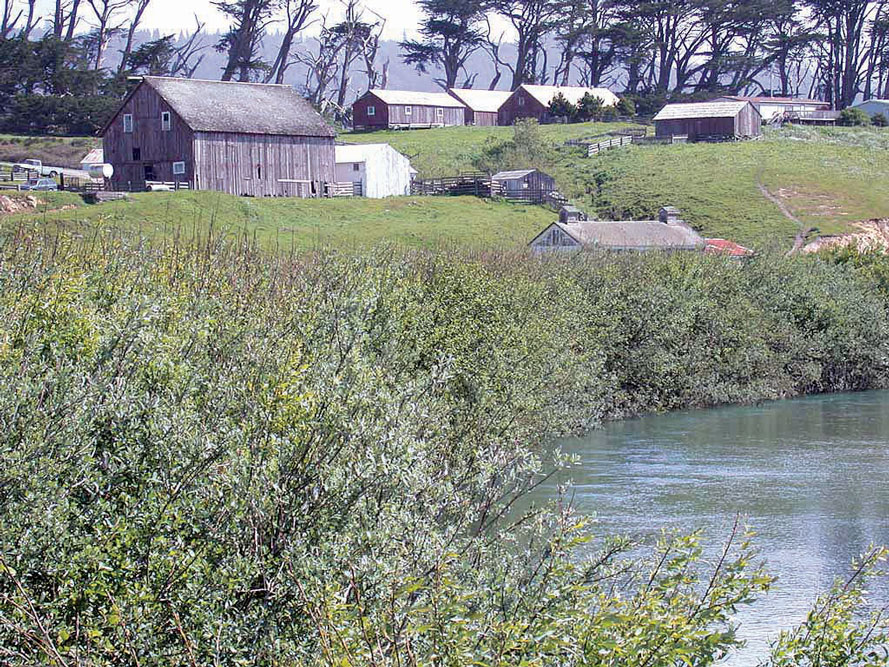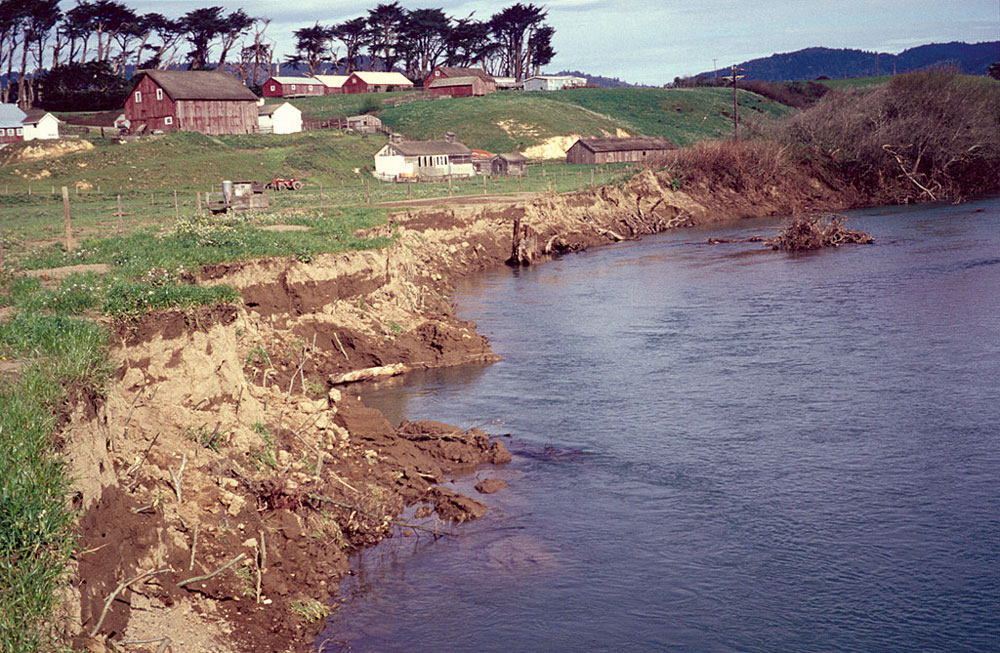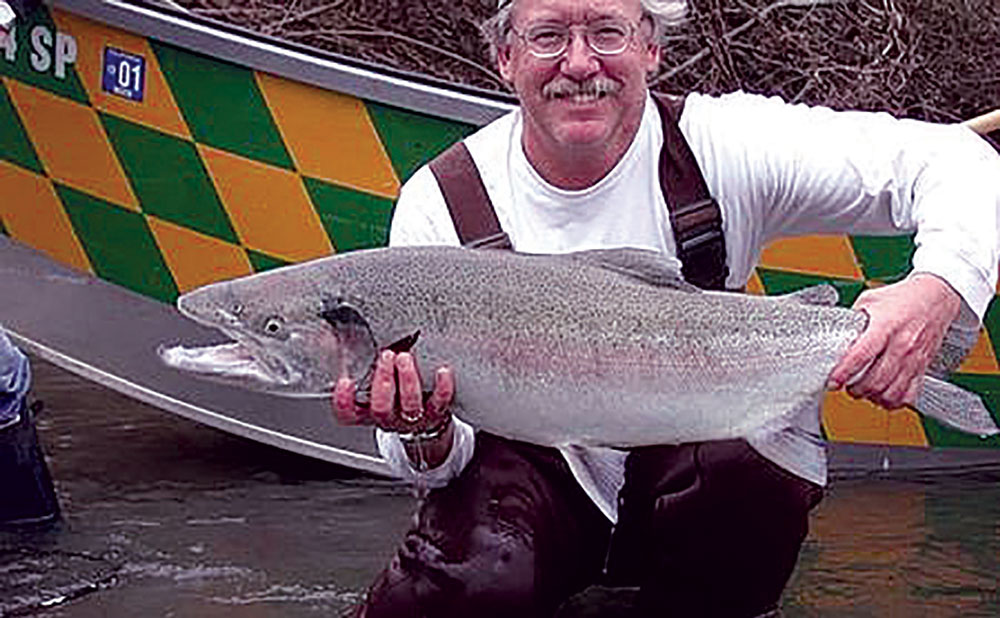The Garcia: A River in Strong Recovery After a 30-Year Effort

By Craig Bell
The strong recovery we are witnessing today in the Garcia River is thanks to a 30-year effort that began in 1991 when Mendocino County Supervisors approved the Garcia River Watershed Enhancement Plan (GRWEP, Caldon, Monschke, Higgins 1991). The GRWEP was the first watershed plan in the county (and maybe the state) that was produced by community stakeholders.
The Garcia River has benefited from the involvement of some of the best restoration practitioners and planners in California. This includes several groups in the Trees Foundation network—Mattole Restoration Council, the Salmonid Restoration Federation, and the Eel River Recovery Project led by Pat Higgins—as well as Pacific Watershed Associates, Bioengineering Associates, Jack Monschke, Mendocino Watershed Service, Trout Unlimited, Kier Associates, Regional Water Quality Control Board staff, Friends of the Garcia, California Department of Fish and Wildlife, NOAA Fisheries, Soil Conservation Service, Mendocino Resource Conservation District, Americorps Watershed Stewards, Northern California Association of River Guides, and others I have likely forgotten.
The GRWEP approved in 1991 spawned many subsequent plans produced through community-based meetings. These include:
- “Garcia River Clean Water Act Total Maximum Daily Load (TMDL) Implementation Plan” (Manglesdorf 1997). This plan, with its enforceable timelines, has been a game-changer for Garcia River recovery.
- Trout Unlimited’s North Coast Coho Project (Trafton, Bell 1998)
- KRIS Garcia (Higgins 2001), the most comprehensive source for Garcia River information
- “Evaluation of Garcia River Restoration with Recommendations for Future Projects” (TU Bell 2002)
- “Aquatic Recovery Strategy” (Bell 2006), part of the Conservation Fund Integrated Resource Management Plan (Griffin 2006)
- “Garcia River Watershed Planning and Coordination Plan” (Bell 2007).
When I first started fishing the Garcia River 40 years ago, the lower river was choked with mud and very fine sediment. If you walk the lower Garcia and the lower Gualala River, you can see how far the Garcia has recovered and how far the nearby Gualala River has to go.

For many years while guiding anglers I have been observing the recovery of healthy spawning gravels and pool depths in the lower 10 miles of the Garcia main stem. In response, increasing numbers of steelhead are choosing to stop their migration and spawn there, even in flows high enough to go anywhere in the watershed. I verified this drifting after each good-sized storm, when I could see that a new batch of chrome-bright steelhead were actively spawning. It is my opinion that they are recognizing the more than suitable gravels and that their juveniles are successfully rearing, out-migrating, and returning as adults. It is also my opinion that the lower main stem of the Garcia will be the driving force for steelhead production and recovery. Folks are under the impression that steelhead are those fish that spawn high up in watersheds. I believe that it was high levels of sediment pollution in the lower main stem(s) of coastal rivers that forced steelhead to upper reaches to find suitable gravels, and that their offspring survived and returned.
In his book Salmon Without Rivers, Jim Lichatowich chronicled how in virtually undisturbed rivers in Russia, salmon exhibited seventeen distinct life histories: lower main stem/tributaries spawning, middle main stem/tributary spawning, upper main stem/tributary spawning. This is coupled with different run timing: summer run, late summer run, fall run, winter run, late winter run, spring run provided for spawning success in any storm/flow pattern. Some of the life histories would be successful every year, providing for robust populations. I think we are now seeing and that ongoing monitoring will show the re-emergence of the lower Garcia generally and of a steelhead late-spring run and successful life histories.
Build It and They Will Come
I can point to no other reason for the recovery of healthy spawning gravels and improved pool depths and steelhead populations in the lower main stem than the comprehensive implementation of the Garcia River Clean Water Act Total Maximum Daily Load (TMDL) Plan that addressed sediment pollution. Not only are there numerous, long reaches of healthy steelhead gravels, there also are increasing reaches of unembedded Chinook spawning gravels. There are increasing sightings of large Chinook now spawning in the Garcia main stem.
The Garcia now has the southernmost small coastal river Chinook run. Additionally, coho salmon were observed this winter spawning in the lower, mid, and upper main stem and three tributaries. Landowners large and small have “buttoned up” over 80% of controllable sediments. In the upper watershed the effort focused mostly on roads. In the lower river landowners agreed to fence cattle out, and bio-engineering projects repaired all erosion sites coupled with extensive riparian planting.
Some Proof
On April 6, 2020, CDFW Warden Don Powers floated the lower 10 miles of the Garcia after a storm. He observed 1,500 adult steelhead spawners. In December 2019 Warden Power spotted 30 large Chinook holding in one hole.
In early May 2021, I received a report from a local fisherman friend that a fresh run of steelhead had entered the Garcia and were spawning in the lower main stem. I decide to try and document this with a spawning survey. Luckily Pat Higgins was in the area with his dive gear and underwater cameras. We counted 150 steelhead redds in seven miles of the lower main stem. The effort began on May 23 and was completed on May 28. We got video footage of adult steelhead actively spawning and many juvenile coho.
Conclusions
- The lower 10 miles of the Garcia River are showing strong signs of physical and biological recovery.
- The regulatory approach of the Garcia River Clean Water Act TMDL Implementation Plan with enforceable timelines has been a success.
- Based on my surveys, the Garcia main stem now has larger amounts of healthy spawning gravels and complex habitat than its tributaries.
- I recommend a yearly spawner survey of the lower 10 miles of the Garcia main stem to document spawner use and recovery.
- It will be important for regulatory agencies to maintain vigilance to prevent future sediment inputs.
- The restoration of estuary floodplain and historic “oxbow” channel habitats would benefit all salmonid juveniles and adults.
- The recovery of the Garcia River is the product of 30 years of effort that started with a community-based recovery plan. State and Federal politicians and funders often ask for proof that the millions of dollars being spent on salmon recovery are working. The Garcia River offers both physical and biologic examples of success.

The Garcia River has potent wild steelhead genetics.
Craig Bell is a Garcia River Watershed Planner, as well as past President of the Salmonid Restoration Federation, Former Logger, Commercial Fisherman, and River Guide. He can be reached at [email protected]
